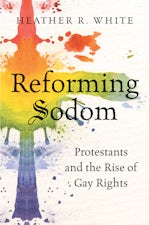Tabernacles of Clay
Sexuality and Gender in Modern Mormonism
By Taylor G. Petrey
288 pp., 6.125 x 9.25
-
Paperback ISBN: 978-1-4696-5622-9
Published: June 2020 -
E-book EPUB ISBN: 978-1-4696-5623-6
Published: April 2020 -
E-book PDF ISBN: 979-8-8908-5900-6
Published: April 2020 -
Hardcover ISBN: 978-1-4696-5621-2
Published: June 2020
Buy this Book
- Paperback $32.50
- Hardcover $99.00
- E-Book $22.99
For Professors:
Free E-Exam Copies
Awards & distinctions
2021 Best Book Award, Mormon History Association
Finalist, 2020 Association for Mormon Letters Award (Religious Nonfiction)
A 2020 Choice Outstanding Academic Title
As Petrey details, LDS leaders have embraced the idea of fixed identities representing a natural and divine order, but their teachings also acknowledge that sexual difference is persistently contingent and unstable. While queer theorists have built an ethics and politics based on celebrating such sexual fluidity, LDS leaders view it as a source of anxiety and a tool for the shaping of a heterosexual social order. Through public preaching and teaching, the deployment of psychological approaches to “cure” homosexuality, and political activism against equal rights for women and same-sex marriage, Mormon leaders hoped to manage sexuality and faith for those who have strayed from heteronormativity.
About the Author
Taylor G. Petrey, associate professor of religion at Kalamazoo College, is author of Resurrecting Parts: Early Christians on Desire, Reproduction, and Sexual Difference.
For more information about Taylor G. Petrey, visit
the
Author
Page.
Reviews
"[A] landmark work on gender and sexuality in Mormon thought. . . . Information-packed, with a forceful thesis and jargon-free prose, this is an important contribution to Mormon studies as well as a convincing consideration of the ways religions construct and maintain frameworks. Any academic studying the intersection of religious practice and progressive social change will want to pick this up."—Publishers Weekly, starred review
"A brilliant exception to studies of sexuality, gender, and religion that too often focus on a narrow subject and don’t speak to broader concerns of larger issues in history and society. . . . Petrey writes beautifully, offering readers across a wide variety of academic fields, including religious studies and the history of sexuality, an elegant intellectual text that will please casual readers as well. Highly recommended."—Library Journal, starred review
“Meticulously researched and well-balanced in structure and argument, Petrey’s book provides new insights into the church’s relationship with gender and sexuality policies. . . . Accessible and addictive in content, this book comes highly recommended.”—Segullah
“Petrey . . . looks at how post–WW II political, social, and cultural transformations shaped LDS church leaders’ conceptions of race, sexuality, and gender. . . . Adding nuance to the history of Mormonism, Petrey’s book is a remarkable addition to the literature.”—CHOICE
"A fascinating, invaluable resource for those interested in Mormon ideas of sexuality and gender." —Association for Mormon Letters
“Petrey’s work bridges a gap in the field of Mormon studies where the study of women is often separated from the study of LGBTQ+ sexuality, obscuring ‘a fundamental overlap between these two issues.’” —Journal of the American Academy of Religion




